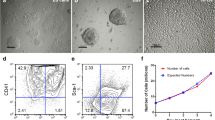Abstract
Purpose
The goals of this study were to optimize radiolabeling of renal lineages differentiated from human embryonic stem (hES) cells and use noninvasive imaging (positron emission tomography (PET) and bioluminescence imaging (BLI)) to detect the cells in fetal monkeys post-transplant.
Procedures
hES cells expressing firefly luciferase (5 × 106) were radiolabeled with the optimized concentration of 10 μCi/ml 64Cu-PTSM then transplanted under ultrasound guidance into early second trimester fetal monkey kidneys. Fetuses were imaged in utero with PET and tissues collected for analysis 3 days post-transplant. Fetal kidneys were imaged ex vivo (PET and BLI) post-tissue harvest, and serial kidney sections were assessed by PCR for human-specific DNA sequences, fluorescent in situ hybridization (FISH) for human-specific centromere probes, and immunohistochemistry (IHC) to assess engrafted cells.
Results
Transplanted cells were readily imaged in vivo and identified at the site of injection; tissue analyses confirmed the imaging findings. Using a semi-quantitative method, one in approximately 650 cells in the kidney was shown to be of human origin by PCR and FISH.
Conclusions
These studies suggest that hES cells differentiated toward renal lineages can be effectively radiolabeled, transplanted into fetal monkey kidneys under ultrasound guidance, monitored with PET post-transplant, and identified by PET, BLI, PCR, FISH, and IHC post-tissue harvest.






Similar content being viewed by others
References
Gulati A, Sarwal MM (2010) Pediatric renal transplantation: an overview and update. Curr Opin Pediatr 22:189–196
U.S. Renal Data System (2009) Annual Data Report (http://www.usrds.org/)
Chevalier RL, Thornhill BA, Forbes MS, Kiley SC (2010) Mechanisms of renal injury and progression of renal disease in congenital obstructive nephropathy. Pediatr Nephrol 25:687–697
Hiatt MJ, Ivanova L, Toran N, Tarantal AF, Matsell DG (2010) Remodeling of the fetal collecting duct epithelium. Am J Pathol 176:630–637
Ivanova L, Hiatt MJ, Yoder MC et al (2010) Ontogeny of CD24 in the human kidney. Kidney Int 77:1123–1131
Tarantal AF, Han VKM, Cochrum KC et al (2001) Fetal rhesus monkey model of obstructive renal dysplasia. Kidney Int 59:446–456
Butt MJ, Tarantal AF, Jimenez DF, Matsell DG (2007) Collecting duct epithelial-mesenchymal transition in fetal urinary tract obstruction. Kidney Int 72:936–944
Matsell DG, Mok A, Tarantal AF (2002) Altered primate glomerular development due to in utero urinary tract obstruction. Kidney Int 61:1263–1269
Batchelder CA, Lee CC, Matsell DG et al (2009) Renal ontogeny in the rhesus monkey (Macaca mulatta) and directed differentiation of human embryonic stem cells towards kidney precursors. Differentiation 78:45–56
Batchelder CA, Lee CC, Martinez ML, Tarantal AF (2010) Ontogeny of the kidney and renal developmental markers in the rhesus monkey (Macaca mulatta). Anat Rec 293:1971–1983
Budde MD, Frank JA (2009) Magnetic tagging of therapeutic cells for MRI. J Nucl Med 50:171–174
Lau JF, Anderson SA, Adler E, Frank JA (2010) Imaging approaches for the study of cell-based cardiac therapies. Nat Rev Cardiol 7:97–105
Libani IV, Lucignani G, Gianelli U et al (2011) Labeling protocols for in vivo tracking of human skeletal muscle cells (HSkMCs) by magnetic resonance and bioluminescence imaging. Mol Imaging Biol. doi:10.1007/s11307-011-0474-6
Nguyen PK, Nag D, Wu JC (2010) Methods to assess stem cell lineage, fate and function. Adv Drug Deliv Rev 62:1175–1186
van Buul GM, Kotek G, Wielopolski PA et al (2011) Clinically translatable cell tracking and quantification by MRI in cartilage repair using superparamagnetic iron oxides. PLoS ONE 6:e17001
Welling MM, Duijvestein M, Signore A, Weerd LV (2010) In vivo biodistribution of stem cells using molecular nuclear medicine imaging. J Cell Physiol 226:1444–1452
Bulte JWM (2009) In vivo MRI cell tracking: clinical studies. Am J Roentgenol 193:314–325
Yaghoubi SS, Jensen MC, Satyamurthy N et al (2009) Noninvasive detection of therapeutic cytolytic T cells with 18F-FHBG PET in a patient with glioma. Nat Clin Pract Oncol 6:53–58
Huang J, Lee CCI, Sutcliffe JL et al (2008) Radiolabeling rhesus monkey CD34+ hematopoietic and mesenchymal stem cells with 64Cu-pyruvaldehyde-bis(N4-methylthiosemicarbazone) for microPET imaging. Mol Imaging 7:1–11
Tarantal AF, Lee CC, Jimenez DF et al (2006) Fetal gene transfer using lentiviral vectors: in vivo detection of gene expression by microPET and optical imaging in fetal and infant monkeys. Hum Gene Ther 17:1254–1261
Tarantal AF (2005) Ultrasound imaging in rhesus (Macaca mulatta) and long-tailed (Macaca fascicularis) macaques: reproductive and research applications. In: Wolfe-Coote S (ed) The Laboratory Primate. Elsevier, Amsterdam, pp 317–352
Jimenez DF, Lee CI, O’Shea CE et al (2005) HIV-1-derived lentiviral vectors and fetal route of administration on transgene biodistribution and expression in rhesus monkeys. Gene Ther 12:821–830
Tarantal AF, Lee CCI, Itkin-Ansari P (2009) Real-time bioluminescence imaging of macroencapsulated fibroblasts reveals allograft protection in rhesus monkeys (Macaca mulatta). Transplantation 88:38–41
Tarantal AF, Lee CCI (2010) Long-term luciferase expression monitored by bioluminescence imaging after adeno-associated virus-mediated fetal gene delivery in rhesus monkeys (Macaca mulatta). Hum Gene Ther 21:143–148
Gambhir SS, Herschman HR, Cherry SR et al (2000) Imaging transgene expression with radionuclide imaging technologies. Neoplasia 2:118–138
Acknowledgments
The authors wish to thank the animal care staff at the California National Primate Research Center and the members of the Center for Molecular and Genomic Imaging in the College of Engineering for their expert technical assistance. These studies were supported by the California Institute for Regenerative Medicine (CIRM) Comprehensive grant no. RC1-00144-1 and the Primate Center base operating grant no. RR00169.
Disclosure
The authors have nothing to disclose.
Author information
Authors and Affiliations
Corresponding author
Rights and permissions
About this article
Cite this article
Tarantal, A.F., Lee, C.C.I., Batchelder, C.A. et al. Radiolabeling and In Vivo Imaging of Transplanted Renal Lineages Differentiated from Human Embryonic Stem Cells in Fetal Rhesus Monkeys. Mol Imaging Biol 14, 197–204 (2012). https://doi.org/10.1007/s11307-011-0487-1
Published:
Issue Date:
DOI: https://doi.org/10.1007/s11307-011-0487-1




